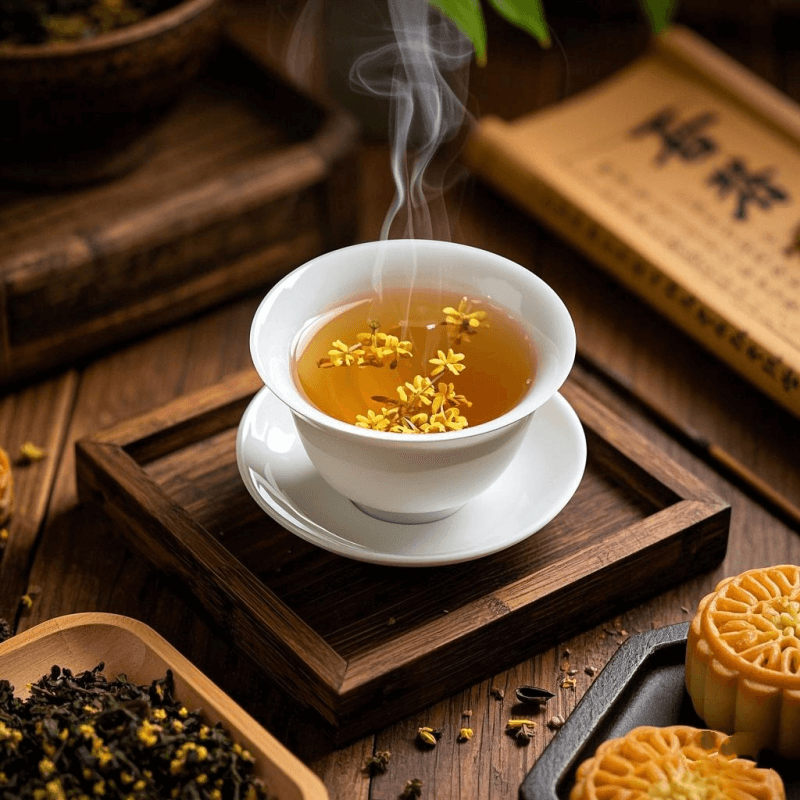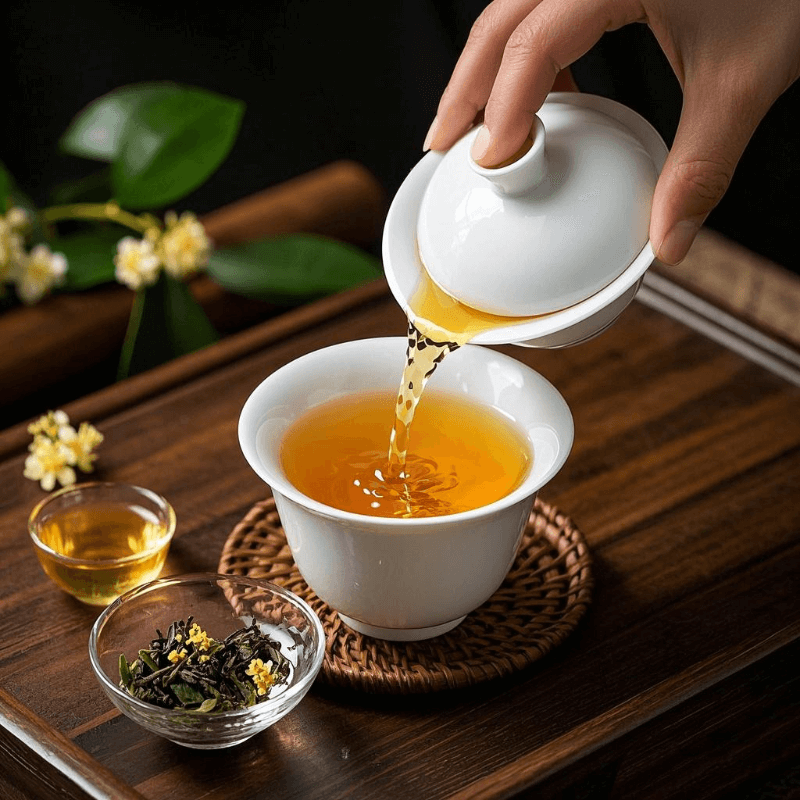
In the realm of scented teas, few combinations rival the elegance of osmanthus oolong tea. This delicate blend marries the complex character of semi-oxidized oolong with the sweet, honeyed fragrance of osmanthus blossoms, creating a sensory experience that transcends ordinary tea drinking. But what makes this floral fusion so captivating, and why has it become a staple in both traditional Chinese tea ceremonies and modern wellness routines?
This comprehensive guide delves into the artistry behind osmanthus oolong tea, exploring its unique production, sensory profile, health benefits, and brewing secrets. Whether you’re a seasoned tea connoisseur or a curious newcomer, prepare to unlock the layers of this extraordinary brew that has charmed palates for centuries.
1. Introduction: Why Osmanthus Oolong Tea Deserves Your Attention
The moment osmanthus oolong tea touches your palate, it’s clear why this beverage has inspired poets and tea masters alike. The question isn’t just about taste—it’s about the way the tea’s floral aroma intertwines with oolong’s deep, rounded flavor, creating a harmony that lingers long after the last sip.
In traditional Chinese medicine, osmanthus flowers have been revered for their calming properties, while oolong tea is celebrated for its metabolism-boosting effects. Together, they form more than a beverage—they create a ritual that balances the senses. As tea sommelier Linda Chen notes, “Osmanthus oolong is not just a drink; it’s a symphony where the boldness of oolong serves as a canvas for the delicate osmanthus notes to shine.”
From its intricate production process to its versatile pairing potential, osmanthus oolong tea offers the perfect blend of tradition and innovation, making it a must-try for anyone seeking to elevate their tea experience.
2. What Is Osmanthus Oolong Tea? A Unique Blend Explained
Osmanthus oolong tea is a masterful creation that combines high-quality oolong tea leaves with the fragrant blossoms of the osmanthus (Osmanthus fragrans), a small tree native to China. Unlike simple flavored teas, authentic osmanthus oolong undergoes a meticulous 窨制 (scenting) process to ensure the flowers’ essence permeates the leaves without overwhelming their natural character.
The Art of Scenting
- Harvesting Blossoms: Osmanthus flowers are picked in late autumn, when their fragrance is most concentrated. They are handpicked to avoid bruising, as even minor damage can alter their aroma.
- Preparing Oolong Leaves: Premium oolong tea leaves, often from varieties like Tieguanyin or Jin Xuan, are carefully dried and sorted to ensure they’re ready to absorb the floral essence.
- Layering and Resting: The tea leaves and flowers are layered in alternating batches inside bamboo baskets. This “scenting” process can take 24–48 hours, during which the leaves slowly absorb the blossoms’ essential oils.
- Removing Flowers: After the scenting, the flowers are gently removed to prevent bitterness, though some blends may retain a few blossoms for visual appeal.
- Final Drying: The scented leaves are lightly roasted to lock in the aroma and enhance the oolong’s natural sweetness.
Cultural Significance
Osmanthus has long been associated with good fortune and longevity in Chinese culture, often featured in mid-autumn festival traditions. Combining it with oolong tea creates a beverage that’s not just flavorful but also steeped in symbolism, making it a popular gift for special occasions.
3. Flavor and Aroma Profile of Osmanthus Oolong
The magic of osmanthus oolong tea lies in its ability to balance two distinct elements: the robust character of oolong and the delicate sweetness of osmanthus. Let’s break down its sensory experience:
Aroma: A Floral Symphony
- Top Notes: Fresh osmanthus blossoms emit a sweet, honey-like fragrance with hints of apricot and ripe peaches.
- Mid Notes: The oolong base contributes earthy, nutty aromas that ground the floral brightness.
- Base Notes: A subtle roasted undertone, more prominent in heavily oxidized oolongs, adds depth and warmth.
Taste: Layers of Delight
- Initial Sip: The palate is greeted by the osmanthus’s natural sweetness, which resembles a light honey or lychee.
- Mid-Palate: The oolong’s characteristic smoothness emerges, with notes of toasted nuts and a hint of creaminess.
- Finish: A long, lingering aftertaste where the floral and tea notes blend into a harmonious sweetness, often described as “mouthwatering” or “refreshing.”
Mouthfeel
- The tea has a medium to full body, with a silky texture that coats the palate without being heavy.
- Properly brewed, it should be free of bitterness, with a balanced astringency that encourages salivation.
Flavor Comparison Chart
| Aspect | Osmanthus Oolong Tea | Plain Oolong Tea |
| Aroma | Intense floral (osmanthus), honey, subtle roast | Varies by oxidation (floral to nutty/roasted) |
| Taste | Sweet, fruity (apricot), balanced by oolong’s depth | Complex, layered (floral to roasted) |
| Aftertaste | Long-lasting floral sweetness | Depends on oolong type (clean to toasty) |
| Body | Silky, medium-full | Varies (light to full) |
4. Health Benefits of Drinking Osmanthus Oolong Tea

Beyond its sensory appeal, osmanthus oolong tea offers a range of health benefits derived from both its tea base and floral infusion:
Antioxidant Powerhouse
- Oolong’s Polyphenols: Like all oolong teas, this blend contains catechins and theaflavins, which act as antioxidants to fight free radicals. A study in Journal of Agricultural and Food Chemistry found oolong tea’s antioxidant activity increases with moderate oxidation.
- Osmanthus Flavonoids: Osmanthus flowers are rich in flavonoids, which have been linked to reduced inflammation and improved heart health, according to Phytomedicine.
Digestive Support
- In traditional Chinese medicine, osmanthus is used to soothe the stomach, while oolong tea aids in digestion by stimulating gastric juices. This makes osmanthus oolong an ideal post-meal beverage.
Mood Enhancement
- Aromatherapeutic Effects: The scent of osmanthus has been shown to reduce stress and anxiety, while the L-theanine in oolong tea promotes a state of calm focus. A 2017 study in Nutrients noted the combination of caffeine and L-theanine in oolong can improve cognitive performance without jitters.
Hydration with Benefits
- Unlike sugary drinks, osmanthus oolong tea provides hydration along with potential metabolic benefits. The moderate caffeine content (30–50mg/cup) offers a gentle energy boost without the crash associated with coffee.
Expert Tip: For maximum health benefits, choose naturally scented osmanthus oolong over artificially flavored versions. Discover the subtle beauty of oolong tea with our premium leaves, where each blend is crafted with real blossoms for authentic flavor.
5. How to Brew Osmanthus Oolong Tea for Best Flavor
Brewing osmanthus oolong tea is an art that requires attention to detail to bring out its complex flavors:
Tools and Ingredients
- Teaware: Gaiwan (lidded bowl) or porcelain teapot to enhance aroma; avoid metal pots that may alter taste.
- Tea Leaves: Use 5–6g (1 teaspoon) of osmanthus oolong per 6–8oz of water.
- Water: Filtered or spring water is ideal; avoid tap water with strong chlorine taste.
Step-by-Step Brewing Guide
- Heat Water to the Right Temperature:
- For lightly oxidized oolongs: 175–185°F (79–85°C) to preserve floral notes.
- For more oxidized oolongs: 195–205°F (90–96°C) to bring out roasted undertones.
- Warm the Vessel:
- Rinse the gaiwan with hot water to preheat, then add the tea leaves.
- First Rinse (Optional):
- Pour hot water over the leaves, swirl gently, and discard within 5 seconds to wake up the leaves and remove any dust.
- Steep for Perfect Flavor:
- First Steep: 20–30 seconds for a bright, floral infusion.
- Subsequent Steeps: Increase steeping time by 10–15 seconds each time (up to 7–8 steeps), as the leaves gradually release their flavors.
- Savor the Experience:
- Pour into small cups, inhale the aroma deeply, then take a sip, allowing the tea to coat your entire palate.
Gongfu Brewing Technique
For the ultimate experience, try gongfu cha (Chinese tea ceremony):
- Use a smaller vessel and higher leaf-to-water ratio.
- Steep for shorter intervals (10–15 seconds initially), enjoying the way the flavor evolves over multiple steeps.
- Elevate your tea experience with authentic oolong teaware, designed to enhance the brewing process and highlight the tea’s nuances.
6. Pairing Osmanthus Oolong with Food and Occasions
Osmanthus oolong tea’s balanced sweetness and floral notes make it a versatile companion for various foods and events:
Culinary Pairings
- Desserts:
- Mooncakes (traditional mid-autumn pastries filled with lotus seed paste)
- Almond cookies or shortbread
- Light fruit tarts or panna cotta
- The tea’s sweetness complements desserts without overwhelming them, while its astringency cuts through richness.
- Savory Dishes:
- Roast duck or chicken
- Sweet and sour pork
- Stir-fried vegetables with oyster sauce
- The tea’s floral notes provide a refreshing contrast to savory flavors, cleansing the palate between bites.
- Cheese Pairings:
- Soft, creamy cheeses like brie or camembert
- Aged gouda or comté
- The tea’s honeyed sweetness pairs beautifully with the nutty flavors of cheese.
Ideal Occasions
- Morning Ritual: Start your day with a lightly oxidized osmanthus oolong for a gentle energy boost.
- Afternoon Tea: Serve with pastries or sandwiches for an elegant tea party.
- Festive Gatherings: Offer as a welcoming beverage during mid-autumn festival or Lunar New Year celebrations.
- Meditative Moments: Use the brewing process as a form of mindfulness, perfect for quiet reflection.
User Feedback: “I served osmanthus oolong at my daughter’s wedding tea ceremony, and guests couldn’t stop commenting on how the tea’s fragrance complemented the occasion’s elegance,” shares tea enthusiast Michael Zhang.
7. Conclusion: Embrace the Fragrant Elegance of Osmanthus Oolong
From its meticulous scenting process to its harmonious blend of flavors, osmanthus oolong tea offers a journey for the senses that few other teas can match. It’s a beverage that bridges tradition and innovation, nature and craftsmanship, creating an experience that’s as nourishing for the soul as it is for the body.
Whether you’re drawn to its floral aroma, health benefits, or the ritual of brewing, incorporating osmanthus oolong into your tea routine is sure to elevate everyday moments into something extraordinary. Each cup is an invitation to slow down, savor the present, and appreciate the beauty of a perfectly balanced blend.
Ready to experience this floral fusion for yourself? Browse our oolong tea collection for every taste preference, where you’ll find carefully curated osmanthus oolong blends that capture the essence of this remarkable tea. Let every sip be a celebration of aroma, taste, and tradition.
As you pour your next cup, remember: osmanthus oolong tea is more than a drink—it’s a story of nature’s bounty and human ingenuity, told in every fragrant sip.
